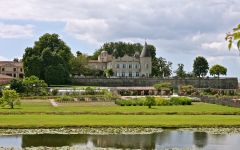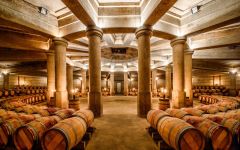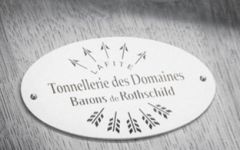Chateau Lafite Rothschild 2020
-
James
Suckling -
Jeb
Dunnuck -
Wine
Enthusiast - Decanter
-
Robert
Parker



Product Details
Your Rating
Somm Note
Winemaker Notes
Blend: 92% Cabernet Sauvignon, 7% Merlot, 1% Petit Verdot
Professional Ratings
-
James Suckling
Amazing aromas here with tobacco, crushed stone, cigar box, currants, tar, and lead pencil, as well as spices, iron, and dried ginger. Medium- to full-bodied, with a density and tightness. Very compact and complex. Racy. Delicacy with strength. Orange peel undertones. A wine to contemplate. You must understand it to understand the great Lafites of the past and those of the future. Only 12.8% alcohol. 92% cabernet sauvignon, 7% merlot and 1% petit verdot. Best after 2030, but drink it if you have the chance taste it.
-
Jeb Dunnuck
Looking at the Grand Vin, the 2020 Chateau Lafite-Rothschild is a sensational effort checking in as 92% Cabernet Sauvignon, 7% Merlot, and the rest Petit Verdot that hit 12.8% natural alcohol and a pH of 3.94. As Lafite as Lafite gets, this ultra-classic reveals a dense ruby/plum hue as well as a tight, yet layered bouquet of ripe blackcurrants, smoked tobacco, freshly sharpened pencils, graphite, and subtle spice. Flawlessly balanced, deep, concentrated, and layered, it has an incredible mid-palate, building, perfect tannins, and a finish that leaves you salivating. Refined, elegant, and perfection are the buzz words here. Unfortunately, it's not for the instant gratification crowd, and I wouldn't be surprised to see this require 15 years to hit the early stages of its prime drinking window. It will probably hit its 100th birthday in fine form. Best After 2038.
-
Wine Enthusiast
Structured, dense and with great concentration, this wine is magnificent. Its black fruits and density indicate the power of the wine and its longevity. At the same time, the wine has the elegance that is always associated with this estate. Drink from 2028.
-
Decanter
This is pretty much as close to entirely Cabernet Sauvignon as Bordeaux gets (92%) and yet it has an incredibly fine, gentle richness to the tannins. They build up pretty quickly though, so that by the end of the palate you start to feel the closing in and tightening, deftly underscoring how well this will age. The kaleidoscope of flavours and aromatics that Lafite does so well is fully on display, nothing trying too hard, a velvet texture to the tannins where the cassis fruit, earth, crushed stone and graphite is held in from beginning to end. Impressive that even in dry vintages like 2020 with the real concerns over global warming, the top Bordeaux estates can still produce wines of this quality.
Barrel Sample: 97 -
Robert Parker's Wine Advocate
The 2020 Lafite Rothschild opens in the glass with a deep bouquet of cassis, black truffle, pencil shavings and violets. Full-bodied, fleshy and layered, its broad attack segues into an ample core of fruit framed by supple, melting tannins. Seamless, layered and complete, it's richer and deeper pitched than the 2019, and its notably high pH of 3.94 likely means it will never shut down. It's a blend of 92% Cabernet Sauvignon, 7% Merlot and 1% Petit Verdot, incorporating just a touch more Merlot from the plateau of Carruades than the 2019. Best after 2027.
Other Vintages
2024-
James
Suckling - Vinous
-
Robert
Parker
-
Robert
Parker -
James
Suckling - Decanter
- Vinous
-
Jeb
Dunnuck
-
Robert
Parker -
James
Suckling -
Jeb
Dunnuck - Decanter
- Vinous
-
Wine
Enthusiast - Vinous
- Decanter
-
James
Suckling -
Robert
Parker -
Jeb
Dunnuck
-
Robert
Parker -
James
Suckling -
Jeb
Dunnuck - Decanter
-
Wine
Spectator
-
Robert
Parker -
Wine
Enthusiast -
James
Suckling -
Jeb
Dunnuck - Decanter
-
Wine
Spectator
-
Robert
Parker -
James
Suckling -
Wine
Enthusiast - Decanter
-
Wine
Spectator -
Jeb
Dunnuck
-
James
Suckling - Decanter
-
Jeb
Dunnuck -
Wine
Enthusiast -
Robert
Parker -
Wine
Spectator
-
Wine
Enthusiast -
James
Suckling - Decanter
-
Jeb
Dunnuck -
Robert
Parker -
Wine
Spectator
-
James
Suckling -
Wine
Enthusiast -
Wine
Spectator -
Robert
Parker - Decanter
-
James
Suckling -
Wine
Enthusiast -
Wine
Spectator
-
Wine
Enthusiast -
James
Suckling -
Wine
Spectator -
Wilfred
Wong -
Robert
Parker
-
Wine
Enthusiast -
James
Suckling -
Wine
Spectator -
Robert
Parker
-
Wine
Enthusiast -
Robert
Parker -
James
Suckling - Decanter
-
Wine
Spectator
-
James
Suckling -
Wilfred
Wong -
Robert
Parker - Decanter
-
Wine
Spectator -
Wine
Enthusiast
-
Robert
Parker -
Wine
Enthusiast -
Wilfred
Wong -
James
Suckling -
Wine
Spectator
-
Wine
Enthusiast -
Robert
Parker -
Wine
Spectator
-
Robert
Parker -
Wine
Enthusiast -
James
Suckling -
Wine
Spectator -
Wine &
Spirits
- Decanter
-
Wine
Enthusiast -
Wine &
Spirits -
Wine
Spectator -
Robert
Parker
-
Wine
Enthusiast -
Wine &
Spirits -
Robert
Parker -
Wine
Spectator
-
Robert
Parker -
James
Suckling -
Wine
Enthusiast -
Wine
Spectator -
Wine &
Spirits
-
Wine
Spectator -
Robert
Parker - Decanter
-
Robert
Parker -
Wine
Spectator
-
James
Suckling -
Wine
Spectator -
Wine
Enthusiast -
Robert
Parker
-
Robert
Parker -
Wine
Spectator
-
Robert
Parker -
Wine
Spectator -
Wine &
Spirits - Decanter
-
Robert
Parker -
Wine
Spectator
- Decanter
-
Robert
Parker -
James
Suckling -
Wine
Spectator
-
James
Suckling -
Wine
Spectator -
Robert
Parker
-
Wine
Spectator -
Robert
Parker
-
James
Suckling
-
James
Suckling
-
Robert
Parker -
Wine
Spectator
-
James
Suckling -
Wine
Spectator -
Robert
Parker
-
Robert
Parker -
James
Suckling -
Wine
Spectator
-
Robert
Parker -
Wine
Spectator
-
James
Suckling - Decanter
-
Robert
Parker -
Wine
Spectator
-
James
Suckling -
Robert
Parker - Decanter
-
Wine
Spectator
-
Robert
Parker
-
Robert
Parker
-
Wine
Spectator
-
Wine
Spectator
-
James
Suckling -
Robert
Parker
-
Robert
Parker
-
Robert
Parker -
Wine
Spectator







Chateau Lafite Rothschild is one of only four classified first growths and thus the designation as 1st er Cru. The vintage rankings of the Universal Paris Exposition in 1855 officially gave Lafite the rating as “Leader among fine wines.” While the first known reference to Lafite dates to 1234 with a certain Gombaud de Lafite, abbot of the Vertheuil Monastery north of Pauillac, Lafite’s mention as a medieval fief dates to the 14th century. The name Lafite comes from the Gascon language term “la hite”, which means “hillock”. There were probably already vineyards on the property at the time when the Ségur family organised the vineyard in the 17th century, and Lafite began to earn its reputation as a great winemaking estate. Jacques de Ségur was credited with the planting of the Lafite vineyard in the 1670s and in the early 1680s. The estate achieved wide popularity in the 1750s when it became the favorite wine of King Louis XV. Thomas Jefferson was also a steadfast customer and even visited the estate. After the 1973-1976 mini-crisis that hit Bordeaux, Baron Eric’s management of the estate made strides forward with a search for excellence and the gradual addition of a new technical team. In 1985 Baron Eric began a tradition of inviting fine-arts photographers to photograph Chateau Lafite. Today, his daughter Saskia de Rothschild represents the 6th generation of the family at the head of the winemaking properties.

One of the world’s most classic and popular styles of red wine, Bordeaux-inspired blends have spread from their homeland in France to nearly every corner of the New World. Typically based on either Cabernet Sauvignon or Merlot and supported by Cabernet Franc, Malbec and Petit Verdot, the best of these are densely hued, fragrant, full of fruit and boast a structure that begs for cellar time. Somm Secret—Blends from Bordeaux are generally earthier compared to those from the New World, which tend to be fruit-dominant.

The leader on the Left Bank in number of first growth classified producers within its boundaries, Pauillac has more than any of the other appellations, at three of the five. Chateau Lafite Rothschild and Mouton Rothschild border St. Estephe on its northern end and Chateau Latour is at Pauillac’s southern end, bordering St. Julien.
While the first growths are certainly some of the better producers of the Left Bank, today they often compete with some of the “lower ranked” producers (second, third, fourth, fifth growth) in quality and value. The Left Bank of Bordeaux subscribes to an arguably outdated method of classification that goes back to 1855. The finest chateaux in that year were judged on the basis of reputation and trading price; changes in rank since then have been miniscule at best. Today producers such as Chateau Pontet-Canet, Chateau Grand Puy-Lacoste, Chateau Lynch-Bages, among others (all fifth growth) offer some of the most outstanding wines in all of Bordeaux.
Defining characteristics of fine wines from Pauillac (i.e. Cabernet-based Bordeaux Blends) include inky and juicy blackcurrant, cedar or cigar box and plush or chalky tannins.
Layers of gravel in the Pauillac region are key to its wines’ character and quality. The layers offer excellent drainage in the relatively flat topography of the region allowing water to run off into “jalles” or streams, which subsequently flow off into the Gironde.
